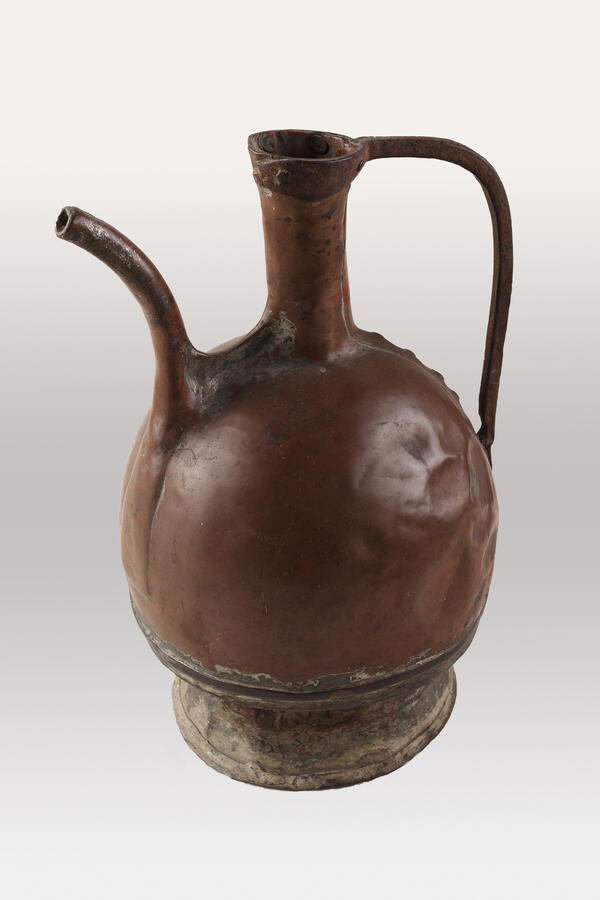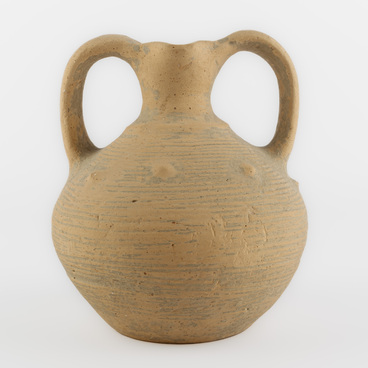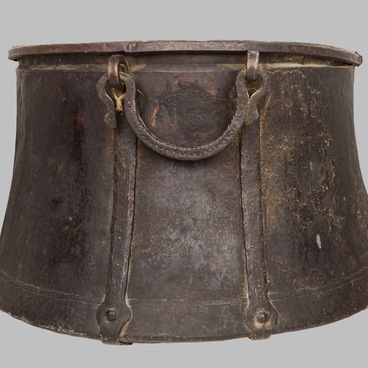A Circassian jug, or kumgan, is a narrow-necked vessel with a spout and a handle. It was designed to carry and store water, and could also be used for ritual and everyday ablutions. The vessel was transferred to the Gelendzhik Museum from the Adyghe Regional Museum in 1971.
To make kumgans, brass, copper, zinc, silver or iron were usually used. Brass and copper were more common, since these materials have greater ductility. To manufacture jugs, craftsmen used hammers and anvils with various shapes of the working surface. In order to process the vessel from the inside, hammers and movable anvils of a special shape were used. Such an anvil was fixed on a bench, and the artisan put a jug blank on it and hit with the hammer from the outside to obtain the desired shape. Kumgans were often coated with chasing and decorated with various water symbols: circles and tubercles symbolized drops, stripes — flowing streams, and arcs, as the researchers suggest, stood for rain clouds. Special rods were used for chasing. The feet, handles and other massive parts of a kumgan were cast in special molds and then soldered or riveted to the vessel. In the Caucasus, copper was the main material used. To prolong the life of the jug, it was tinned, that is, covered with a thin layer of tin inside and outside. Tinning protected the metal from external influences and adverse processes, in particular from corrosion, and made the product more wear resistant. This procedure was periodically repeated, and the profession of a tinker was in great demand.
How did kumgans get to the Northwest Caucasus? It is believed that kumgans came to the Caucasus along with the spread of Islam in the 16th century. In Islam, ablution is a very important process of not only physical, but also ritual cleansing. Without ablution, Muslims cannot perform religious rites and touch the Koran. Despite the fact that the Circassians continued to adhere to the customs of their ancestors and the new religion spread very slowly, the lighter and more practical copper utensils quickly became popular with the locals and replaced ceramics.
To make kumgans, brass, copper, zinc, silver or iron were usually used. Brass and copper were more common, since these materials have greater ductility. To manufacture jugs, craftsmen used hammers and anvils with various shapes of the working surface. In order to process the vessel from the inside, hammers and movable anvils of a special shape were used. Such an anvil was fixed on a bench, and the artisan put a jug blank on it and hit with the hammer from the outside to obtain the desired shape. Kumgans were often coated with chasing and decorated with various water symbols: circles and tubercles symbolized drops, stripes — flowing streams, and arcs, as the researchers suggest, stood for rain clouds. Special rods were used for chasing. The feet, handles and other massive parts of a kumgan were cast in special molds and then soldered or riveted to the vessel. In the Caucasus, copper was the main material used. To prolong the life of the jug, it was tinned, that is, covered with a thin layer of tin inside and outside. Tinning protected the metal from external influences and adverse processes, in particular from corrosion, and made the product more wear resistant. This procedure was periodically repeated, and the profession of a tinker was in great demand.
How did kumgans get to the Northwest Caucasus? It is believed that kumgans came to the Caucasus along with the spread of Islam in the 16th century. In Islam, ablution is a very important process of not only physical, but also ritual cleansing. Without ablution, Muslims cannot perform religious rites and touch the Koran. Despite the fact that the Circassians continued to adhere to the customs of their ancestors and the new religion spread very slowly, the lighter and more practical copper utensils quickly became popular with the locals and replaced ceramics.



